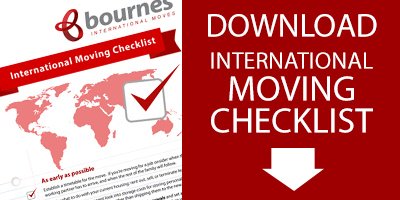If you're moving to Canada you may be wondering which items of your personal effects, furniture and other belongings you should take with you when you emigrate and what you should be leaving behind. Here's a quick guide on what to ship to Canada when you emigrate...
If you're thinking of taking up personal residency and making a home in Canada, or even just relocating to Canada you should consider some facts before you start drawing up your list of goods to pack.
As with moving anywhere in the world there are a few things to think about before you've arrived in Canada. These include what items you take with you and what you leave behind, costs like duties and tax free items, and how to get your personal effects or household goods over by the most cost effective means.
Out of all of these considerations things like customs clearance at the Canada border services agency when taking over household effects could hamper you from even getting to enter Canada. This is where an international removal company can really step in and take on the burden of facilitating your international move. So, with all that said, what should you expect to ask these companies, and what international moving tips are most pertinent? We've narrowed it down to these two all-encompassing questions:
- What will it cost to ship your furniture and effects to Canada? (How to go about trying to import vehicles, for example.)
- What will it cost to replace items when you get there? (What to do if you've lost household effects in your move with or without an international moving company.)
The first way of looking at what to ship to Canada is ‘don’t ship more than you have to’. One of the main elements of shipping costs is the volume, so the less boxes and furniture you ship the cheaper it will likely be. If you are shipping a full container then it makes sense to fill it as the main cost is the freight space, which won’t change, the only variable costs are insurance (usually a % value of your goods) and packing costs, but this aren’t significantly different for a few extra items. Groupage (shared container loads) on the other hand means paying for only the space you take up, so the more you use the more you pay, so here a few extra items can change costs a little more.
The second thing to consider is how much it will cost to replace the items you don't take but still need. Often, the cost of replacement is higher than the cost of shipping. Shipping also means you don't have the stress of shopping around when you get there, and have the added benefit of familiarity of home, helping you to settle in quickly.
Usually, it is a good idea ship the things you will still need in your home in Canada, with the exception of those items that wont work or fit in your new home. De-cluttering is a good idea to reduce wasted cost, but check carefully the costs of anything you plan to replace first.
What household items should I ship to Canada?
Furniture to ship
 In Canada furniture can (whilst often being of high quality) be expensive, Canadian houses are on average slightly bigger than in the UK so more space to fill up - something to bear in mind before you start offloading or selling your current furniure!
In Canada furniture can (whilst often being of high quality) be expensive, Canadian houses are on average slightly bigger than in the UK so more space to fill up - something to bear in mind before you start offloading or selling your current furniure!
Tip - Try to have a look at furniture retailers (either during a scouting trip or online stores) and see what it would cost to replace items you’re thinking of leaving behind, and compare this with the cost of shipping them.
Appliances & Electrical goods to ship
TVs can be used in Canada, with just a few things to check first. Make sure the power range covers 110v, you’ll be able to plug this in with a simple adapter, if it doesn’t cover 110v then you’ll have to get an additional transformer too. Your TV will need to be multi-region to receive analogue TV in Canada as this uses the NTSC signal type vs. PAL in the UK. Freeview will not pick up digital TV in Canada as again the digital signal type is different. Cable TV can be hooked up to your UK TV using a set top box providing you have the right connections. DVD players will also need to be multi-region to play locally purchased DVD’s, Canada is Region 1 whereas UK is Region 2.
Clothes and personal effects to ship
As you might expect, clothes and shoes are no problem when shipping to Canada. Things like ornaments, pictures and kitchenware should all be fine too - though as per the above adivce, you might want to check the compatability of any electrical items like hairdryers and kitchen appliances before you pack them.
Tip: always keep important or sentimental items on your person during the move. Expensive items like laptops, cameras and jewellery and irreplacable items like photographs can be kept in hand luggage for peace of mind. Always keep important paperwork and documentation on you too, and make copies that can be uploaded to a storage device like an online Cloud or hardrive.
What should I not ship to Canada?
Furniture not to ship
As mentioned previously, furnitre in Canada can be very expensive to buy brand new, so whilst you might want to ship as much as you can from home it's worth noting that a lot of homes in Canada have built in wardrobes (or “closets” if we’re going to get the lingo right!), so it is probably not worth shipping wardrobes to Canada unless you can check first that your property doesn’t have them built in.
Appliances & electrical items not to ship
There are some items you should probably not bother taking due to incompatibility of electrical voltage in Canada (the power source of Canada is 110v, the power source in the UK is 220v.) For example leave behind your major appliances like fridge/freezers. Smaller items that are dual voltage are ok but check first that their voltage range includes 110v. Some 220v appliances can be used in Canada but you’ll need additional transformers and adapters to plug them in and change the voltage.
Tip - White goods will often come as part of the sale when you buy or rent a house in Canada, so check this out beforehand. Small appliances like toasters, kettles etc are relatively cheap so not usually worth shipping as you’d have to use a voltage converter and adapter to operate anyway.
Prohibited Items
Certain items are completely banned by Customs from entering Canada. These include:
- Fresh fruit
- Firewood
- Most weaponary, including tasers, brass knuckes and pepper spray
- Certain knives - including those used for fishing and hunting
- Obscene material, hate propaganda and child pornography
- Any camping gear that is not completely clean and free of pests or soil.
Restricted items that require a permit or license:
- All firearms and weapons. Anything that is not declared will be seized and you may face criminal charges
- Any live bait
- Any type of radio transmitter
Regulations on what is permitted do change from time to time though, so it's always worth double checking on anything you're not sure about before you leave.
Things to look out for when importing Household goods to Canada
Canadian border services have cracked down on goods entering Canada that are contaminated with soil, so make sure to scrub clean any items that have been used outdoors or contain traces of soil to avoid costly and stressful procedures should your goods be inspected and found non-compliant. These goods will be refused entry and you’ll be responsible for the costs of return shipment / cleaning or ultimate disposal. Think about garden furniture, shoes, garden tools and equipment and bicycles/sporting equipment.
When moving to Canada, personal effects imported for your own use and owned by you do not attract duty or other taxes on arrival, providing you have owned and used them prior to departure. An exception however can be tools that you identify you will use commercially for your work which will not be eligible as household effects and therefore subject to customs duties.
Shipping vehicles to Canada
If you need to import a vehicle into Canada, be aware of the Canadian import laws. The vehicle must meet the requirements of the Canada Border Service Agency (CBSA), Transport Canada and the Canadian Food Inspection Agency (CFIA) before it can be imported. For returning Canadian citizen/resident, a vehicle may be imported if it was originally manufactured for Canadian or U.S. (modifications may be needed) markets or if it’s older than 15 years. Vehicles not manufactured for Canadian or U.S. markets are not allowed to be imported.
For temporary residents, the above restrictions do not apply. They can import their vehicles as long as they are re-exported at the expiration of their work permits. Temporary import vehicles may not be sold or disposed of in Canada. These requirements apply to cars, trucks, vans motorcycles, snow mobiles, motor homes, trailers or any other equipment mounted on rims and tires.
A vehicle cannot be imported that was manufactured to meet the safety standards of a country other than the U.S. or Canada unless the vehicle is the following.
• 15 years or older (excluding buses)
• A bus manufactured before January 1, 1971
• Entering Canada temporarily
If your vehicle is less than 15 years or is bus manufactured on or after January 1, 1971, you must prove that your vehicle qualifies for one of the above exemptions. Vehicles must be completely clean of any type of dirt. A certificate of cleaning is recommended.
Find out more about moving vehicles to Canada
Need more help deciding what to ship to Canada?
If you're still confused about what you can and can't ship to Canada when you move then there's lots of help available. One of the benefits of using an experienced international removal company is that they will always have experts on hand to advise you every step of the way when it comes to what you can and can't ship. Your international Move Manager will also be able to help you when it comes to filling in all your paperwork correctly and also keep you up to date on any major changes in shipping restrictions or things that can affect your shipment.
Bournes provides free advice and no obligation quotes to help you arrange removals to Canada so get in touch with us and we'll be happy to help.
Check out the Ultimate Guide On How To Move Your Belongings Overseas to find out everything you need to know about finding and using a professional overseas mover.

.png)










